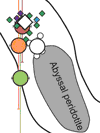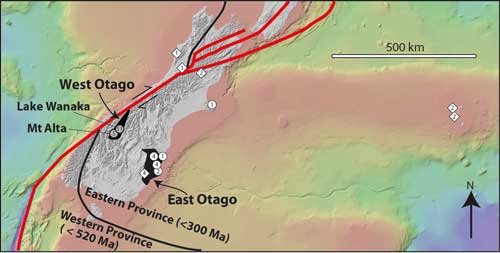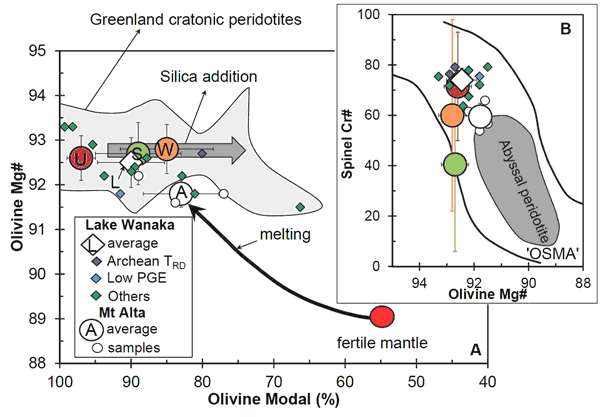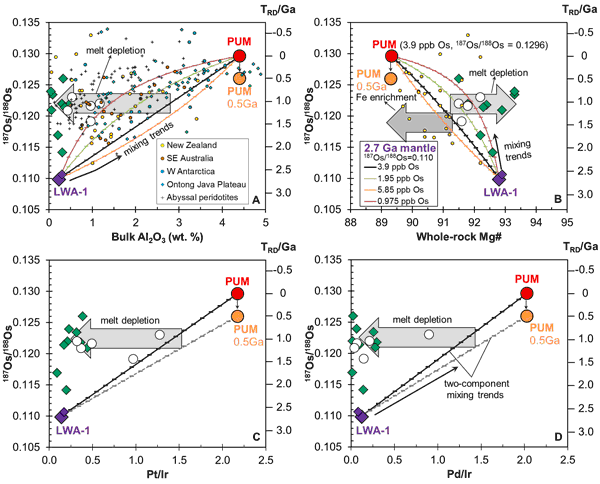 |
The longevity of Archean mantle residues in the convecting upper mantle and their role in young continent formation |
Jingao Liu1, James M. Scott2, Candace E. Martin2, D. Graham Pearson1
1Department of Earth and Atmospheric Sciences, University of Alberta, 1-26 Earth Science Building, Edmonton, Alberta, Canada T6G 2E3; jingao@ualberta.ca ; gdpearso@ualberta.ca
2Department of Geology, University of Otago, Leith Street, Dunedin 9054, New Zealand; james.scott@otago.ac.nz ; candace.martin@otago.ac.nz
This webpage is a summary of: Liu J. et al., 2015. The longevity of Archean mantle residues in the convecting upper mantle and their role in young continent formation. Earth. Planet. Sci. Lett. 424, 109-118.
Earth’s continents are underlain by melt-depleted lithospheric mantle that protects them from the disruptive effects of asthenospheric mantle convection. The role that buoyant, viscous, highly depleted mantle has played in preserving Archean cratonic crust through to the present day has become clear through Os isotope studies of peridotite xenoliths erupted by kimberlites (Walker et al., 1989; and more recent studies reviewed by Pearson & Wittig, 2014). Less clear is the relationship between post-Archean crust and its underlying lithospheric mantle. For example, could ancient lithospheric mantle act as a “life-raft” that promotes attachment of younger crust (McBride et al., 1996; Handler et al., 1997, 2003; Peslier et al., 2000a,b; McCoy-West et al., 2013; Mundl et al., 2015)? Alternatively, are the relicts of ancient melting events entrained in the convecting mantle flow and later sampled by volcanic or orogenic events, as suggested for oceanic settings (Parkinson et al., 1998; Brandon et al., 2000; Meibom and Frei, 2002; Harvey et al., 2006; Bizimis et al., 2007; Pearson et al., 2007; Liu et al., 2008; Simon et al., 2008; Dijkstra et al., 2010; Stracke et al., 2011; Rampone & Hofmann, 2012; Lassiter et al., 2014)? To answer these questions, we studied peridotite xenoliths from Earth’s youngest continent–Zealandia–and report the largest decoupling of young crust and underlying old lithospheric mantle age (~2.4 Ga) so far observed on Earth. We examined the potential cause for such extreme age decoupling and this sheds light on the questions posed above.
Within Zealandia, intraplate basaltic-to-lamprophyric lavas have transported many mantle peridotite xenoliths to the surface over the last ~85 Ma. These peridotite xenoliths (Figure 1) permit investigation of the lithospheric mantle beneath Zealandia, where no crust older than 520 Ma has so far been found. In central Zealandia, the xenoliths are primarily in the East Otago and West Otago areas (Figure 1; Reay & Sipiera, 1987; Scott et al., 2014a). Osmium and hafnium isotope data from a small selection of fairly fertile-to-moderately-depleted peridotite xenoliths on the eastern side of New Zealand (East Otago; Figure 1) show that parts of the sampled lithospheric mantle experienced Paleoproterozoic melt depletion (McCoy-West et al., 2013; Scott et al., 2014a). This has led to the suggestion that this young continent is underlain by an ancient lithospheric mantle that has provided a stable platform, since the Paleoproterozoic, onto which various fragments of continental materials were accreted (McCoy-West et al., 2013).

Figure 1: A satellite gravity map of central-southern Zealandia showing the distribution of peridotite xenolith locations for which there are Re-Os isotope data (modified from Scott et al. 2014a). White symbols are data from McCoy-West et al. (2013) where the circles define their “Waitaha domain”; gray symbols are from our study. The number inside each symbol indicates the number of samples analysed from each location. Dark fields show the extent of xenolith-bearing magmatism in West Otago and East Otago. The Australia-Pacific plate boundary is shown in red. The thick black line shows the important Zealandia geological subdivision between the Eastern Province (Carboniferous and younger terranes <300 Ma) and the Western Province (Cambrian-Early Paleozoic terranes < 520 Ma; Scott, 2013).
A suite of newly discovered peridotite xenoliths from the western side of New Zealand (Lake Wanaka and Mt. Alta, West Otago; Figure 1) has strong compositional affinities to cratonic mantle (Figure 2) supporting the possibility of an Archean mantle root beneath much younger (< 300 Ma) crust. However, this inference lacks geochronological evidence. The 187Re–187Os isotopic system in mantle peridotites has been extensively used because it provides a reliable means of dating formation of lithospheric mantle, while platinum group element (PGE) systematics can be used to investigate the extent of melt depletion and potential subsequent alteration in the peridotites (Pearson et al., 2004; Liu et al., 2011). Using whole-rock Re-Os isotopes and PGE we examined the timing and extent of melt depletion processes in the lithospheric mantle beneath this region to try to establish the temporal relationships between crust and lithospheric mantle and to evaluate the role of ancient depleted lithospheric mantle in the formation of a much younger continent.

Figure 2: A). Olivine Mg# (100 x Mg/(Mg+Fe2+)) versus olivine modal abundance for mantle peridotites from West Otago, New Zealand. The schematic melting curve is from Boyd (1989). The field labelled “Greenland cratonic peridotites” contains data from the Ubekendt (Bernstein et al., 2006), Wiedemann (Bernstein et al., 1998), and Sarfartoq (Garrit, 2002) suites. The large symbols labeled with upper-case letters indicate the average for each suite, with 1σ error bars. The arrow field marks possible silica addition to account for the high orthopyroxene modes. B). Olivine Mg# versus spinel Cr# (100 x Cr/(Cr + Al)). ‘OSMA’: olivine-spinel mantle array from Arai (1994). Given the large errors in the spinel Cr# of the cratonic peridotites, the error bar marks the total range, whereas it indicates 1σ for the West Otago peridotites.
The Lake Wanaka and Mt Alta peridotites from West Otago have rhenium-depletion Os model ages that vary from 0.5 to 2.7 Ga (Figure 3), firmly establishing an Archean depletion event. However, the vast range in depletion ages does not correlate with melt depletion or metasomatic tracer indices, providing little support for the presence of a significant volume of ancient mantle root beneath this region. Instead, the chemical and isotopic data are best explained by mixing of relict components of Archean depleted peridotitic mantle residues that have cycled through the asthenosphere on timescales of Ga, along with more fertile convecting mantle (Figure 3). Extensive melt depletion associated with the “docking” of these melt residues beneath the young continental crust of the Zealandia continent explains the decoupled age relationship that we observe today. Hence, the newly formed lithospheric root incorporates a mixture of ancient and modern mantle derived from the convecting mantle, cooled and accreted in recent times. We argue that in this case, the ancient components played no earlier role in continent stabilization, but their highly depleted nature along with that of their younger counterparts now represents a highly viscous, stable continental keel. This model could account for the large spectrum of ages observed in fertile-to-moderately-depleted peridotites sampled from lithospheric mantle beneath SE Australia, W Antarctica and other locations in Zealandia, as well as the oceanic mantle (Figure 3). Our data confirm the longevity and dispersal of ancient depleted mantle domains in the convecting mantle and their re-appearance beneath young continents.

Figure 3: (A) 187Os/188Os vs. Al2O3 content, (B) whole-rock or olivine Mg#, (C) Pt/Ir and (D) Pd/Ir. The mixing scenarios are calculated, with increments of 5%, between relict Archean component (represented by sample LWA-1 but having variable siderophile-element concentrations, e.g., Os concentration ranges from a 0.25 to 1.0 and half of that of PUM) and ambient fertile mantle (PUM, modern or 0.5 Ga). PUM: 187Os/188Os = 0.1296 from Meisel et al. (2001), and calculated 187Os/188Os = 0.1260 at 0.5 Ga. Arrow fields mark the possible additional processes to account for the data. Data sources are given in Liu et al. (2015). Click here or on Figure for enlargement.
References
-
Arai, S., 1994. Characterization of spinel peridotites by olivine-spinel compositional relationships: review and interpretation. Chem. Geol. 113, 191-204.
-
Bernstein, S., Hanghøj, K., Kelemen, P.B., Brooks, C.K., 2006. Ultra-depleted, shallow cratonic mantle beneath West Greenland: dunitic xenoliths from Ubekendt Ejland. Con. Min. Pet. 152, 335-347.
-
Bernstein, S., Kelemen, P.B., Brooks, C.K., 1998. Depleted spinel harzburgite xenoliths in Tertiary dykes from East Greenland: restites from high degree melting. Earth Planet. Sci. Lett. 154, 221-235.
-
Bizimis, M., Griselin, M., Lassiter, J.C., Salters, V.J., Sen, G., 2007. Ancient recycled mantle lithosphere in the Hawaiian plume: osmium–hafnium isotopic evidence from peridotite mantle xenoliths. Earth Planet. Sci. Lett. 257, 259-273.
-
Boyd, F.R., 1989. Compositional distinction between oceanic and cratonic lithosphere. Earth Planet. Sci. Lett. 96, 15-26.
-
Brandon, A.D., Snow, J.E., Walker, R.J., Morgan, J.W., Mock, T.D., 2000. 190Pt-186Os and 187Re-187Os systematics of abyssal peridotites. Earth Planet. Sci. Lett. 177, 319-335.
-
Dijkstra, A.H., Sergeev, D.S., Spandler, C.A., Pettke, T., Meisel, T., Cawood, P.A., 2010. Highly refractory peridotites on Macquarie Island and the case for anciently depleted domains in the Earth’s mantle. J. Pet. 51, 469-493.
-
Garrit, D., 2002. The nature of the Archean and Proterozoic lithospheric mantle and lower crust in West Greenland illustrated by the geochemistry and petrography of xenoliths from kimberlites. Unpublished PhD thesis, University of Copenhagen, pp 289.
-
Handler, M.R., Bennett, V.C., Esat, T.M., 1997. The persistence of off-cratonic lithospheric mantle: Os isotopic systematics of variably metasomatised southeast Australian xenoliths. Earth Planet. Sci. Lett. 151, 61-75.
-
Harvey, J., Gannoun, A., Burton, K.W., Rogers, N.W., Alard, O., Parkinson, I.J., 2006. Ancient melt extraction from the oceanic upper mantle revealed by Re–Os isotopes in abyssal peridotites from the Mid-Atlantic ridge. Earth Planet. Sci. Lett. 244, 606-621.
-
Lassiter, J.C., Byerly, B.L., Snow, J.E., Hellebrand, E., 2014. Constraints from Os-isotope variations on the origin of Lena Trough abyssal peridotites and implications for the composition and evolution of the depleted upper mantle. Earth Planet. Sci. Lett. 403, 178-187.
-
Liu, C.Z., Snow, J.E., Hellebrand, E., Brügmann, G., von der Handt, A., Büchl, A., Hofmann, A.W., 2008. Ancient, highly heterogeneous mantle beneath Gakkel ridge, Arctic Ocean. Nature 452, 311-316.
-
Liu, J., Rudnick, R.L., Walker, R.J., Gao, S., Wu, F.-y., Piccoli, P.M., Yuan, H., Xu, W.-l., Xu, Y.-G., 2011. Mapping lithospheric boundaries using Os isotopes of mantle xenoliths: An example from the North China Craton. Geochim. Cosmochim. Acta 75, 3881-3902.
-
McBride, J.S., Lambert, D.D., Greig, A., Nicholls, I.A., 1996. Multistage evolution of Australian subcontinental mantle: Re-Os isotopic constraints from Victorian mantle xenoliths. Geology 24, 631-634.
-
McCoy-West, A.J., Bennett, V.C., Puchtel, I.S., Walker, R.J., 2013. Extreme persistence of cratonic lithosphere in the southwest Pacific: Paleoproterozoic Os isotopic signatures in Zealandia. Geology 41, 231-234.
-
Meibom A., Frei, R., 2002. Evidence for an ancient osmium isotopic reservoir in Earth. Science 296, 516-518.
-
Meisel, T., Walker, R.J., Irving, A.J., Lorand, J.-P., 2001. Osmium isotopic compositions of mantle xenoliths: a global perspective. Geochim. Cosmochim. Acta 65, 1311-1323.
-
Mundl, A., Ntaflos, T., Ackerman, L., Bizimis, M., Bjerg, E.A., Hauzenberger, C.A., 2015. Mesoproterozoic and Paleoproterozoic subcontinental lithospheric mantle domains beneath southern Patagonia: Isotopic evidence for its connection to Africa and Antarctica. Geology 43, 39-42.
-
Parkinson, I.J., Hawkesworth, C.J., Cohen, A.S., 1998. Ancient mantle in a modern arc: Osmium isotopes in Izu-Bonin-Mariana forearc peridotites. Science 281, 2011-2013.
-
Pearson, D.G., Irvine, G.J., Ionov, D.A., Boyd, F.R., Dreibus, G.E., 2004. Re-Os isotope systematics and platinum group element fractionation during mantle melt extraction: a study of massif and xenolith peridotite suites. Chem. Geol. 208, 29-59.
-
Pearson, D.G., Parman, S.W., Nowell, G.M., 2007. A link between large mantle melting events and continent growth seen in osmium isotopes. Nature 449, 202-205.
-
Peslier, A.H., Reisberg, L., Ludden, J., Francis, D., 2000a. Os isotopic systematics in mantle xenoliths; age constraints on the Canadian Cordillera lithosphere. Chem. Geol. 166, 85-101.
-
Peslier, A.H., Reisberg, L., Ludden, J., Francis, D., 2000b. Re–Os constraints on harzburgite and lherzolite formation in the lithospheric mantle: a study of northern Canadian Cordillera xenoliths. Geochim. Cosmochim. Acta 64, 3061-3071.
-
Rampone, E., Hofmann, A.W., 2012. A global overview of isotopic heterogeneities in the oceanic mantle. Lithos 148, 247-261.
-
Scott, J.M., 2013. A review of the location and significance of the boundary between the Western Province and Eastern Province, New Zealand. NZ J. Geol. Geophys. 56, 276-293.
-
Scott, J.M., Waight, T.E., Van der Meer, Q.H.A., Palin, J.M., Cooper, A.F., Münker, C., 2014a. Metasomatized ancient lithospheric mantle beneath the young Zealandia microcontinent and its role in HIMU-like intraplate magmatism. Geochem., Geophys., Geosys. 15, 3477-3501.
-
Simon, N.S., Neumann, E.R., Bonadiman, C., Coltorti, M., Delpech, G., Grégoire, M., Widom, E., 2008. Ultra-refractory domains in the oceanic mantle lithosphere sampled as mantle xenoliths at ocean islands. J. Pet. 49, 1223-1251.
-
Stracke, A., Snow, J.E., Hellebrand, E., Von Der Handt, A., Bourdon, B., Birbaum, K., Günther, D., 2011. Abyssal peridotite Hf isotopes identify extreme mantle depletion. Earth Planet. Sci. Lett. 308, 359-368.
last updated 2nd July, 2015 |
